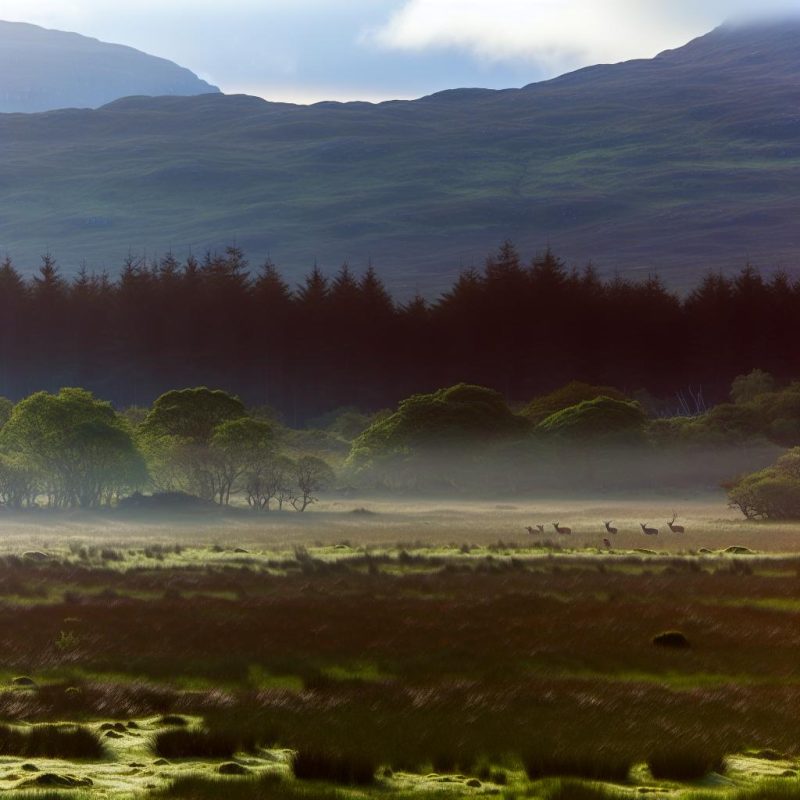Red Deer on the Isle of Jura
The Isle of Jura, a part of the Inner Hebrides of Scotland, is notable for its immense population of red deer. These fascinating creatures are among the island’s most distinguishing characteristics, with deer numbers surpassing those of the human population by a large margin. On Jura’s diverse and rugged terrain, red deer roam at liberty, rendering the island an indispensable destination for wildlife enthusiasts.
Characteristics of Red Deer
Red deer, with their scientific designation as Cervus elaphus, are the largest land mammals native to the British Isles. These animals are distinguished by their reddish-brown fur, which tends to darken as winter approaches. The mature males, referred to as stags, hold a special allure with their extraordinary antlers. These antlers can grow to an impressive length of up to one meter. A fascinating aspect of red deer biology is the annual cycle of shedding and regrowing their antlers, which reach their full grandeur during the autumn rutting season. The stags’ antlers are not merely ornamental; they serve a vital role during the rut, when stags engage in intense contests to win over potential mates.
Best Time for Spotting Red Deer
Autumn, particularly from late September to early November, stands out as the prime season for observing red deer on Jura. During this time, the stags are exceedingly active, driven by the imperative of the rut. This period is marked by fierce competitions among the males vying for female attention. Observers on the island can witness not only the visual spectacle of these engagements but also the aural experience of the stags’ powerful bellows reverberating across Jura’s landscapes. These dramatic displays highlight the vigor and determination of the stags, providing an incredible experience for wildlife enthusiasts who make the journey to Jura during this specific season.
Other Wildlife on Jura
Apart from the renowned red deer population, Jura is a sanctuary for a diverse array of wildlife species. The island’s wide-ranging ecosystems offer refuge and sustenance for numerous birds, mammals, and marine life forms.
Birdlife
For birdwatchers, Jura is an exceptional destination, presenting opportunities to view majestic birds of prey such as golden eagles, hen harriers, and peregrine falcons. The island’s rugged coastlines are also home to seabirds like puffins and razorbills. Bird watchers will find ample chances for observation by exploring Jura’s strategic vantage points, each promising a different perspective on the island’s avian life. The diversity of birdlife on Jura adds a thrilling dimension for those committed to exploring the full range of the island’s natural environments.
Marine Mammals
The marine environment surrounding Jura further enriches its wildlife offerings. Visitors frequently witness harbor seals and otters along the island’s shores, where these creatures can often be seen basking on rocks or playfully diving in the waves. Furthermore, the chance to encounter dolphins and minke whales occasionally, albeit less frequently, offers an added layer of excitement to the wildlife experience. The presence of these marine mammals reflects the rich biodiversity of the waters around Jura and provides additional motivation for visitors aiming to grasp the full scope of the island’s natural beauty.
Walking and Hiking Routes
Jura’s extensive walking and hiking trails provide ideal opportunities for wildlife watching, as well as allowing tourists to fully appreciate the island’s unparalleled vistas. Among the most celebrated hikes is the trek through the Paps of Jura, which presents not only a demanding challenge but also affords expansive views of the islands and the wildlife habitats sprawled below. For outdoor enthusiasts keen on mapping their adventure routes, resources such as Walkhighlands serve as invaluable guides while planning excursions across Jura’s scenic and wildlife-rich terrains. Navigating these trails, visitors encounter a variety of habitats that teeming with life, offering glimpses into the dynamic interplay of species that call Jura home.
Responsible Wildlife Watching
In the pursuit of observing Jura’s wildlife, maintaining a responsible approach is imperative. Observers are urged to keep a considerate distance from the animals, drawing back to ensure that the creatures’ natural behaviors remain undisturbed by human presence. Sticking to established paths and minimizing noise can preserve the tranquility of the environment, ensuring that both the wildlife and the ecosystems they inhabit are left unharmed. An awareness and adherence to local guidelines help in safeguarding the delicate balance of Jura’s ecosystems for future generations. Visitors who familiarise themselves with these practices not only contribute to the preservation efforts but also enhance their own experience by reducing their ecological footprint. To facilitate an enriching and sustainable wildlife experience, those planning a visit are encouraged to consult the Islay & Jura Tourism page, which provides comprehensive information on the island and its rich offerings.
In summary, the Isle of Jura, with its prolific red deer population and diversified wildlife, presents an exceptional opportunity for wildlife observation and appreciation. The island’s natural allure, coupled with its commitment to conservation and responsible tourism, positions Jura as a sought-after destination for nature enthusiasts and wildlife watchers alike.

